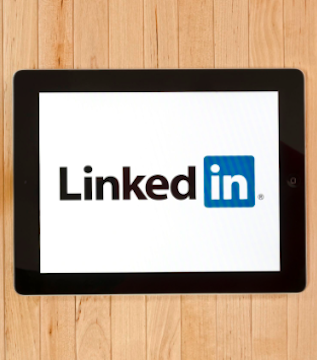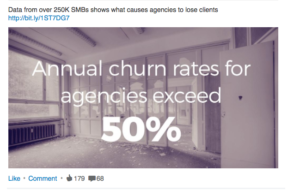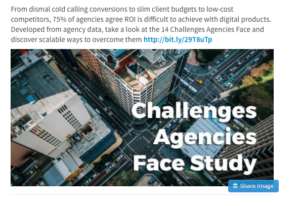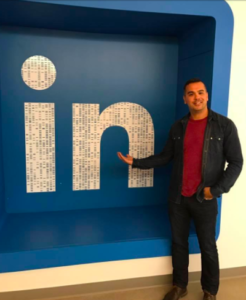
Vendasta generates 1000 leads with LinkedIn advertising
B2B marketers are not great at using social media to generate leads. It’s not just our opinion, only 7% of technology purchasers say they are influenced by the social media that 76% of technology companies are creating (Walker Sands, Marketing Charts).
For the most part, marketers repost content on social platforms, without building a clear lead generation strategy, or creating content valuable enough for a prospect to trade for an email. But there is another way to using social media that is often overlooked: Advertising on LinkedIn. Like Facebook for the B2C market, ads are super targeted, and a relatively cheap source of leads if used correctly. Here is a case study that shows how to do it.
Company: Vendasta
Key executive: Jason Taylor, Demand Generation Strategist
Initiative: LinkedIn advertising
Challenge
When Taylor set out to create a LinkedIn advertising campaign, it was a relatively new experience for the company. The challenge was to drive a significant number of actionable leads for agencies and newspapers for the sales force to close at an acceptable ROI.
He wanted lead generation program, not a clicks to the website or blog posts, but valuable information his market wanted enough to trade their email, and which also qualified them as a prospect.
Strategy
Some of the work creating campaigns was already created by a competency in understanding customers and a deep knowledge of messaging. Here are some of the tactics Taylor deployed:
1. Utilized a customer profile. Customer profiles are already deeply embedded in the Vendasta culture. Ever new marketer is given a set and you can see the evidence in the clarity of messages (shameless self promotion, you can create as many as you want, edit, download, share and archive on this site, here. We just want your email). So Taylor had this piece to start with.
2. Identified a data driven component in the message. “Agency churn exceeds 50%” is a statistic this market is paying attention to. Again, the massive content strategy and blogging that Vendasta engages in allowed Taylor to more easily surface this kind of compelling data.
3. Found an amazing image. Taylor notes images increase engagement by 200%. The empty office (a failed agency) helped focus on the pain point (ouch!) and engage agencies.
4. Selected the the audience “type in” the job titles. There is a drop down for this, but Taylor says the options are overly broad and competition for “senior” executives is fierce.
“You only want the right people clicking or your budget will be gone in no time. Really narrow down your personas (e.g., small business owner, digital director, founder, etc.)”
5. Selected groups as part of the target. When Taylor deselected “groups” his CTR dropped from 1.1% to .3%. Best practice is to keep group selections turned on.
6. Understood that the content, not the ad, gets the leads. Taylor did not suggest exactly how he creates lead generating content in the crowded marketplace for digital information, but he did say that generic content like “50 Social media tips” will not perform.
7. Created a lead generation-based ad and landing page.
Here just the 6th and 7th top performing ads created for the program. The landing pages matched these ads with an email capture in return for valuable information.


Results
Results from the approach were so impressive that Taylor was able to write a content marketing blog with the classic headline, “How I Got LinkedIn To Take Me to a Hockey Game (Without Spending a Fortune)”
- Taylor says he generated 1000 MQL’s (marketing qualified leads) over a six month campaign
- CPL was $70 and a 93% qualified lead rate.
- LinkedIn, perhaps interested in creating case studies of their own, was so interested in the 1.1% CTR, that they contacted him to find out how he did it, and even took him to the Maple Leafs hockey game – a big deal in Toronto, where tickets can cost $500 a seat and a beer is $20. You can read his full blog here.
- The first ad was more effective than the second one, as “Churn” is more specific concern than “challenges.” Identifying these hyper specific issues can be picked up with careful attention to the customer persona (you can build one from our tool on this site here). This in the agony business can almost feel their heart rate increase at the word “churn,” it is an emotional hot button issue in business. No one likes it.
With so many competitors sure to read his blog, it is not surprising that Taylor failed to disclose his top five ads in this blog.
Conclusion
Taylor succeeded in part by getting into the heads of prospective buyers – a hyper competitive space with low barriers to entry – and fully utilizing the targeting power of LinkedIn ads. The four data collection reports he listed all focus on the pain-points with words like “churn,” “challenge” and “survival.”

Taylor at LinkedIn headquarters






Comments are closed.